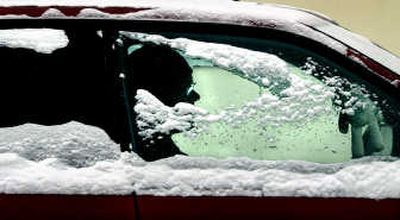Slush, sliding, whiteouts: wintry words of wisdom

Slow down. Increase your following distance. Check your equipment. Most people have heard all the winter driving warnings.
But what’s a driver to do when faced with specific, very bad situations? Driving experts A.J. Seitz, owner of 911 Driving School, and Idaho State Police Lt. Chris Schenck offer the advice you need to handle several winter driving scenarios.
•Whiteout conditions: It may seem like you should pull off to the side of the road if heavy snow is keeping you from seeing more than 20 feet in front of your car, but both Schenck and Seitz recommend against that.
Other drivers will also be having trouble seeing, and if you’re stopped they may be more likely to hit you. Instead, slow way down and continue in the right lane. If there are crazy drivers speeding (which there probably will be), they’ll be more likely to be traveling in the left lane.
•The car up the hill starts sliding backward toward you: That can be a scary situation and is a good reason to leave plenty of distance between your vehicle and the vehicle ahead of you, said Seitz.
If the road is icy, stopping isn’t a great idea because with no forward momentum it could be impossible for you to get your car moving up the hill again. So if the car ahead is sliding slowly and moving toward the side of the road, Seitz advises proceeding slowly and driving around it. If the driver stays in the middle of the road there may not be much you can do.
If it looks like you will have to stop on a hill, angle your car toward the left to position yourself to make a downhill U-turn if necessary.
•Deep slush: Those days when heavy snow starts melting can be pretty hazardous. The heavy slush can almost act like wet concrete.
“When the slush is on the edges of the road, when you hit that it’s going to pull your vehicle that way,” said Schenck, who added that slush on the centerline can pull vehicles into the path of oncoming traffic.
Watch for the slush and try to keep the vehicle in areas of the roadway with consistent conditions. Keep a firm grip on the wheel.
•Sliding on black ice: “You don’t want to hit the brakes because that’s going to increase the skidding,” said Seitz. Instead, take your foot off the gas to slow down. Steer into the skid. That means that if the rear of your car is sliding right, steer right to straighten the vehicle out, he said.
•One clear lane, one snow-covered lane: It’s tempting to want to pass slow traffic in the clear right lane of a highway, but think twice if the left lane is covered in compacted snow and ice, said Schenck.
“We respond to many crashes because of that,” Schenck said. “As you’re giving the car more gas to accelerate and pass, it has a greater tendency for those tires to break loose.” That could mean sliding into the right lane or oncoming traffic.
It’s better to just be patient and stay in the right lane.
Worst winter drivers
Here are a few of Getting There’s least favorite winter drivers:
Four-wheel-drive Guy: He thinks that because his four-wheel-drive truck can get through a snowdrift he can barrel down the road at high speeds because his Extra-super-duty-jumbo- monster-truck/SUV’s four-wheel drive will allow him to stop on a dime. Wrong. He’s not stopping faster than the driver of a front-wheel drive Honda. In fact, he’ll stop slower because of the weight of the rig.
Television Windshield Woman: She doesn’t want to get cold and wet and has just a credit card to work with anyway, so she clears only a miniscule portion of the windshield of snow and ice. Then she drives blind down the road, showering everyone else around her with the snow flying off the top of her car.
Bad Equipment Driver: This is the person who motors around in a rear-wheel-drive junker with bald tires and then complains that he’s slipping because the city doesn’t do enough to clear the streets.
Send in your nominations for worst winter drivers to the contact information at the end of the column.
Eagles keep on riding
Eastern Washington University students will pay $6.50 a quarter to continue a program that allows the school’s students to ride Spokane Transit Authority buses with simply a flash of their Eagle Card.
Students voted to allocate the new fee at the end of the last school year. Until now the full cost of the bus program was met by existing student fees and contributions from EWU’s general budget and Parking Services budget. The $370,000 cost this school year will be evenly split between the new fee and the two other budgets, said EWU spokesman Dave Meany.
Students overwhelmingly saw value in the program, approving the fee by a 3-to-1 margin. About a quarter of them used STA to get to and from school in October.
Faculty and staff are not included in that fee and won’t pay for the program.